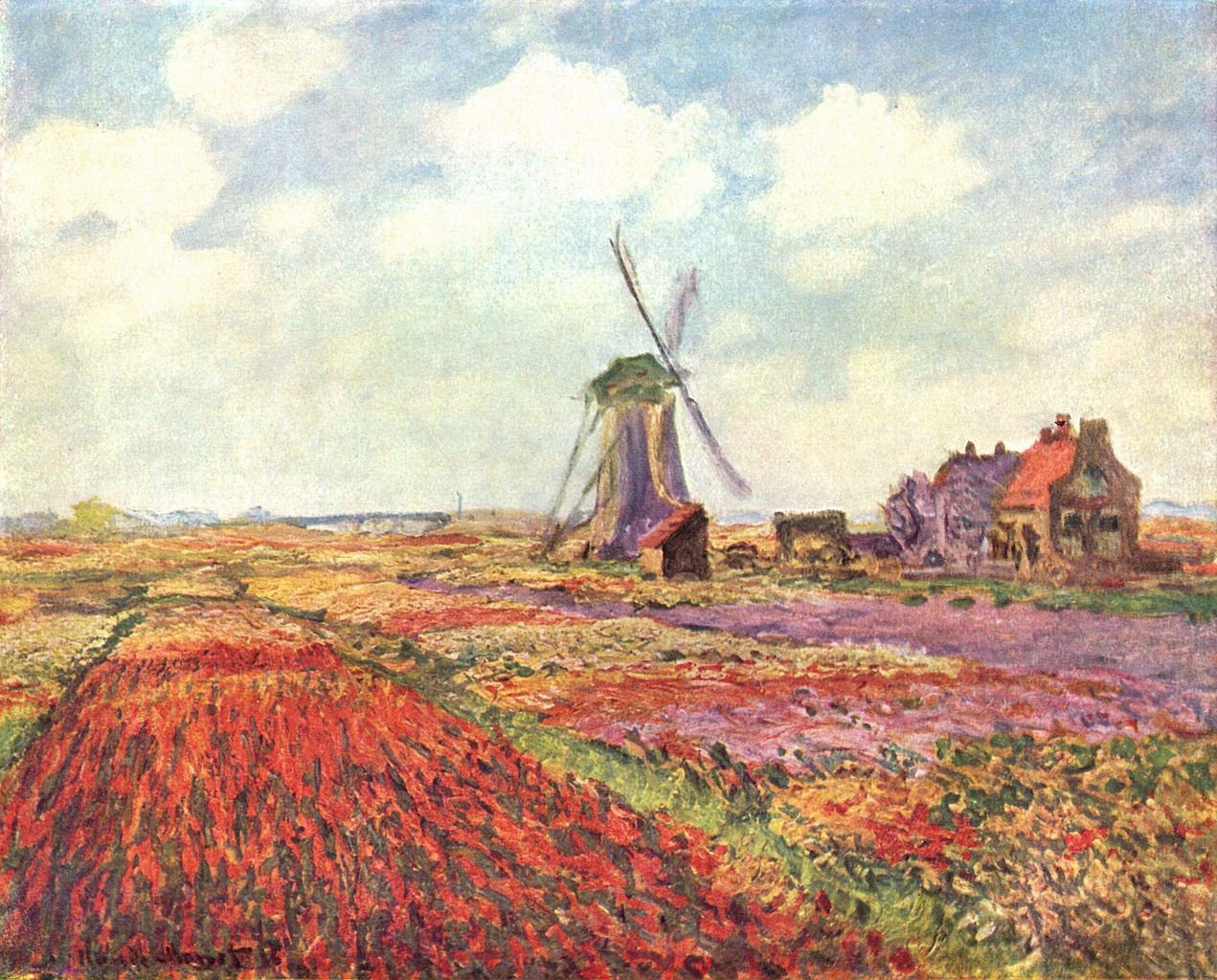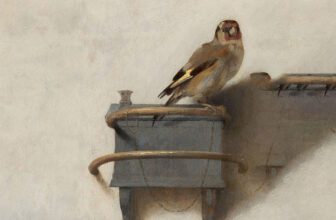
The Meaning, Symbolism of Field of Tulips in Holland Painting
Claude Monet, a name synonymous with Impressionism, transformed the art world through his dedication to light, color, and atmospheric interpretation. One of his lesser-known yet deeply evocative works is “Field of Tulips in Holland,” a vibrant celebration of color and rural life painted during one of his brief travels outside France. While not as widely analyzed as his Water Lilies or Haystacks series, this painting offers a compelling glimpse into Monet’s evolving style and the essence of the Impressionist movement. This in-depth story post delves into the meaning, symbolism, interpretation, and artistic context of Field of Tulips in Holland, while also tracing its current location and significance in art history.
Overview of the Painting
Field of Tulips in Holland (sometimes referred to as Tulip Fields with the Rijnsburg Windmill) was painted in 1886 when Claude Monet took a trip to the Netherlands. The canvas is a quintessential Impressionist piece, featuring wide swathes of vividly colored tulip fields set beneath a broad, open sky. In the distance stands a solitary windmill, a hallmark of the Dutch landscape, and beyond it, a cluster of small, low buildings suggesting a quiet village. The composition is horizontal, emphasizing the vastness of the fields and the sky above them.
What Is the Painting All About?
At its surface, Field of Tulips in Holland is a landscape painting , a depiction of Dutch tulip fields in full bloom. However, Monet’s work is never just about a literal scene. Rather than striving for photographic realism, Monet captured the mood, light, and sensory impressions of a moment in time. The painting encapsulates his fascination with the interplay between light and color, a cornerstone of his artistic philosophy.
Monet had a deep appreciation for nature’s changing moods and the way light altered the perception of color. In this painting, he does not focus on individual tulips or the anatomical accuracy of the windmill. Instead, he offers an emotional response to the scene , an impression. This response is what makes the painting distinctly Impressionist.
Moreover, the painting can be viewed as a visual homage to Dutch landscape traditions, which inspired many French painters, including Monet. Dutch painters like Jacob van Ruisdael and Meindert Hobbema had long explored themes of agricultural beauty and expansive skies, and Monet’s work nods subtly to their legacy.
Symbolism and Interpretation
1. The Tulips – Celebration of Color and Life
The most immediate symbol in the painting is, of course, the tulips. These flowers have deep cultural significance in Dutch history, tied to the “Tulip Mania” economic phenomenon of the 17th century. However, Monet was not interested in economic allegory , at least not overtly.
For Monet, the tulips represent the triumph of nature and the explosion of life in spring. The bands of colors , reds, yellows, purples , are not just botanical facts; they are living paint strokes, each pulsating with energy. The tulips become metaphors for artistic freedom. Their arrangement in long, parallel bands creates a visual rhythm that invites the viewer to walk through the field mentally, losing oneself in the harmony of color.
2. The Windmill – Stability in Movement
The windmill in the distance is a symbol of Dutch identity, but it also functions metaphorically. Windmills were traditionally associated with industry, perseverance, and transformation , they harness the wind, an unpredictable force, and turn it into something productive. In the context of Impressionism, this is a potent metaphor: taking fleeting, momentary impressions and turning them into permanent art.
Positioned on the horizon, the windmill also anchors the painting. It provides a sense of continuity and stability amid the dynamic brushstrokes of the sky and tulip fields. The vertical presence of the windmill counterbalances the horizontality of the fields, adding structural integrity to the composition.
3. The Sky – Infinite Possibilities
The sky in Monet’s Field of Tulips in Holland takes up a significant portion of the canvas. Light blues and soft whites suggest a clear day, perhaps morning or late afternoon. The sky in Impressionist art is rarely just “sky”; it is atmosphere, mood, and a vast emotional canvas. In this painting, it represents openness, potential, and the boundless energy of the natural world.
The soft clouds may hint at transition , a theme Monet often explored. Just as the sky changes moment to moment, so does perception, emotion, and experience. The sky invites contemplation, serving as a reminder of the ephemeral nature of beauty and life itself.
What Is Happening in the Painting?
Unlike narrative-driven art that tells a story through action, Monet’s painting invites a different kind of engagement. Nothing “happens” in the traditional sense. There are no people, no dramatic events. Yet in the stillness, there is motion: the sway of tulips in the breeze, the slow rotation of the windmill, the drift of clouds overhead.
This quietude is intentional. Monet asks the viewer to slow down and observe , to notice how the colors vibrate against each other, how the perspective draws the eye toward the horizon, how the simplicity of the scene contains multitudes. It’s a painting about being, not doing.
By capturing a moment of stillness, Monet evokes the constant movement of time and light. This paradox , stillness as a metaphor for change , is a hallmark of his artistic genius.
What Type of Art Is It?
Field of Tulips in Holland is a quintessential example of Impressionism, the art movement that Claude Monet helped pioneer in the late 19th century. Impressionist art is defined by several key characteristics:
Loose brushwork: Monet used quick, spontaneous strokes to mimic the effects of light and movement.
Focus on light: The way light alters color and perception is central to the piece.
Everyday subject matter: Impressionists often painted contemporary life and nature, not historical or mythological themes.
Outdoor scenes (plein air): Monet painted this work likely from direct observation, capturing the tulip fields in natural light.
Color over line: Rather than precise outlines, Monet used color contrasts to define shapes and space.
In many ways, this painting is also a precursor to Color Field Painting , a 20th-century movement that emphasized broad fields of color to evoke emotion. Though unintentional, Monet’s tulip bands foreshadowed that aesthetic evolution.
Claude Monet’s Journey to the Netherlands
Monet traveled to the Netherlands several times during his career, drawn by its serene landscapes, diffused northern light, and rich artistic traditions. The Dutch emphasis on naturalism, vivid color palettes, and luminous skies influenced Monet profoundly.
In 1886, the year he painted Field of Tulips in Holland, Monet was already a seasoned Impressionist. He was exploring new ways to push his technique beyond the confines of traditional landscape painting. His time in Holland allowed him to experiment with broader fields of color and more daring compositional strategies.
The tulip fields of the Netherlands offered a kind of natural abstraction. Rows of color planted by farmers unintentionally mirrored the brushstrokes of a modern painter. Monet recognized this and used it to create one of his most vibrant, celebratory works.
Where Is the Field of Tulips in Holland Painting Now?
Today, Field of Tulips in Holland is housed in a private collection, though it has been displayed at major exhibitions, including shows dedicated to Monet’s travels or the broader scope of Impressionism. Because it is not part of a permanent museum collection, its visibility to the public is limited. However, high-quality reproductions and academic documentation make it accessible to scholars and art lovers worldwide.
Its relative obscurity in Monet’s oeuvre makes it a hidden gem , a rare look at how the artist explored new environments and motifs outside his more famous themes like water lilies or Parisian scenes.
Cultural Impact
Though not as iconic as Monet’s other masterpieces, Field of Tulips in Holland plays a crucial role in understanding his broader artistic journey. It bridges French and Dutch landscape traditions while emphasizing the power of color and composition over narrative or detail.
For contemporary audiences, the painting offers a welcome antidote to complexity , a return to pure visual pleasure and emotional resonance. In a world often overwhelmed by noise, Monet’s tulip field invites viewers into a realm of quiet, radiant beauty.
Moreover, it reminds us that art doesn’t need drama to be profound. Sometimes, a field of flowers under an open sky is enough to speak volumes.
Field of Tulips in Holland by Claude Monet is more than a beautiful painting. It is an exploration of perception, a meditation on nature, and a celebration of color’s expressive potential. Through vivid tulips, a distant windmill, and an expansive sky, Monet conveys the richness of life and the fleeting magic of a single moment.
In this relatively understated work lies the essence of Impressionism: the desire to capture not what we see, but how we experience seeing. For Monet, and for those who continue to admire his legacy, that difference is everything.
Whether you’re a seasoned art historian or a casual admirer, Field of Tulips in Holland offers something precious , a quiet reminder of nature’s beauty, and the boundless creativity of the human spirit.




